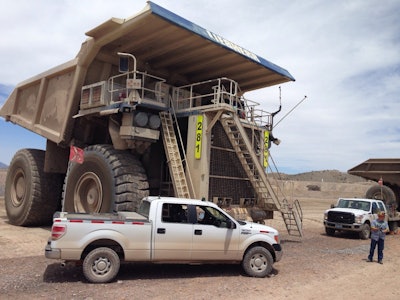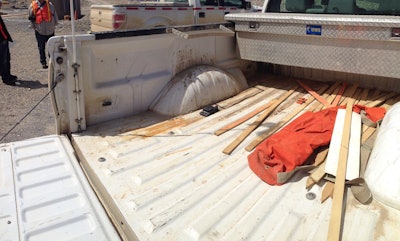
[imagebrowser id=85]
“Drive it like you stole it and work it hard.”
Those were the marching orders Denis Kanseir, the lead prototype engineer on Ford’s 2015 F-150’s, gave the drivers of six pickups distributed evenly among three different companies when they were handed the keys back in the latter half of 2011.
- Barrick Mining, Elko, Nevada: Bald Mountain and Cortez gold mines.
- Walsh Construction: Hydroelectric dam construction in Lancaster, Pennsylvania and a highway interchange site in Birmingham, Alabama.
- Regional utility company in North Carolina
Before the automaker released the first aluminum-bodied pickup to the public, Ford wanted to be sure the metal could handle the abuse its most demanding customers would throw at it. The automaker recently announced that the 2015 F-150 is its most patented pickup yet.
What Kansier kept secret from the companies and their drivers was the 4×4 pickups had their steel beds swapped out for aluminum beds as part of a real-world test to work out any design flaws before the aluminum bodied 2015s started production.
The six trucks were part of 11 F-150 “X-1 Prototype” vehicles Kansier had at his disposal for this secret field testing.
“We put an enormous amount of R&D time doing our own lab and field testing,” says Kansier as we look down at monster-sized shovels and dump trucks from a viewing point a thousand feet above the Barrick Cortez open pit gold mine 70 miles south of Elko, Nevada.
“We will have more than 10 million miles of combined testing before the first production F-150 rolls off the assembly line later this year. About 200,000 of those miles will have accumulated right here in Nevada at the Barrick gold mines” says Kansier.
“We always learn a lot placing our trucks in extreme work conditions like this where they face conditions we don’t anticipate or can’t replicate in our own testing,” says Kansier who was tasked with making sure the aluminum bed was up to the durability of the steel model that had been around forever.
The utility company gave one of the trucks to a meter reading crew that regularly drives up steep mountain roads and the other to a line crew that often drives through overgrown paths to replace old poles and lines. In all, the trucks were driven an average of 200 miles each day. When the meter crew removed the tailgate to improve visibility, Ford engineers took note and modified the height of the tailgate in the final 2015 F-150 design.
 Ford’s prototype F-150 were quietly tested at two of Barrick Mining’s gold mines.
Ford’s prototype F-150 were quietly tested at two of Barrick Mining’s gold mines.But the most abuse to the prototypes has come from Barrick, one of Ford’s largest fleet customers in the mining industry with some 700 F-Series pickups and E-Series vans in their Nevada fleet. That’s why they were selected as one of the three companies to get a pair of X1 F-150s.
Mine site surveyors Derek Brown and Mike Sena were two of Barrick’s surveyors assigned driving the trucks and the perfect guys to put the ordinary looking, white F-150s to the real-wold endurance test Kansier needed.
An open-pit mine surveyor’s job at Barrick encompasses daily mapping of every active area of the operation from setting up blast fields to measuring ever-changing mountains of material being removed and relocated in the quest for gold.
They can easily put 100-300 miles a day just driving the mine site’s dirt and rock roads, which can be dust-dry one day and knee-deep with mud the next. The trucks see a lot of hard use in a 12-hour shift.
“I put about 200 miles a day on my pickup and a hundred of that is on dirt road just getting to and from work,” says Brown who is a surveyor at Barrick’s Bald Mountain Mine some 150 miles from where we are watching dump trucks the size of small apartment buildings move “overburden” from the ever-widening and deepening open pit to a dump site a mile away on another level of the Cortez site.
“Right now the odometer on the pickup Ford gave us is close to 75,000 miles. And the truck hasn’t had any mechanical issues. The bed is a little beat up because it gets stuff tossed in there everyday and I’m sure the shocks are shot. But it’s held up well.”
Both of the X1 F-150 prototypes are on site and we jump in Sena’s for a trip down to where the 24/7 gold mining operation is in full swing.
The odometer on his X1 is approaching 90,000 miles and the crew cab 4×4 looks like a work truck.
Little stalagmites of dry mud hang from the rockers where steps once had a purpose, the interior has a smooth layer of fine grey dust from floor to headliner, and the cloth seats show typical jobsite stains and wear.
The mud tires, which Sena say rarely last 8,000 miles on his F-150 in the rugged conditions, are already chunking and look like they are close to seeing their last days on the Cortez roads.
Things look little better between the cab and tailgate. The bed has taken a beating. There’re big chips of paint missing where heavy tools were unceremoniously tossed over the tailgate an untold number of times and gouges where drill bits and other heavy, sharp items have been drug out and rolled about.
 Lots of abuse. No rust.
Lots of abuse. No rust.The dull sheen of aluminum shows everywhere in the bed where white paint once existed. There’s not a spot of rust anywhere; not in the paintless recesses of the dents and dings, not on the heads of the exposed steel rivets.
Kansier loves it.
“This kind of ordinary mining work truck abuse is what we were looking for when we gave these guys the X1 F-150’s with the aluminum bed. And we learned a few things in the process and made design changes to the 2015 so it’d be better than the steel bed,” he says.
Kansier points out three specific changes from the steel bed design as a result of the X1 testing: 1) increasing the aluminum bed floor thickness; 2) using an additional under-bed floor crossmember between tailgate and wheel-well; 3) and further recessing the tailgate access panel.
The Ford engineers also added a new lab test as a result of the X-1 field test program: The Pintle Drop.
At one point in the field test a driver was removing the pintle hitch and dropping it over the tailgate into the bed to save time. The continuos pounding of the 40-pound pintle deformed the bed floor and the sharp edge of the pintle attaching plate had punctured the 1.2mil aluminum used on the first X-1 floors.
Hence the 2-mil-thick bed floor in the 2015 model, the added bed support in the new truck — and a new durability test for future Ford trucks in the lab.
Another driver was dragging big chains out of the bed an the hook ends snagged on the aluminum tailgate’s access panel, bending it upward.
Kansier took that tailgate to the design team, who subsequently changed the design so the lip of the panel is now several millimeters deeper than it is on the current steel bed’s tailgate. Problem solved.
So when you get to see a 2015 F-150, now you’ll know the story behind the bed. By the way, all of the X1s ares still being used everyday by the now famous test teams.










